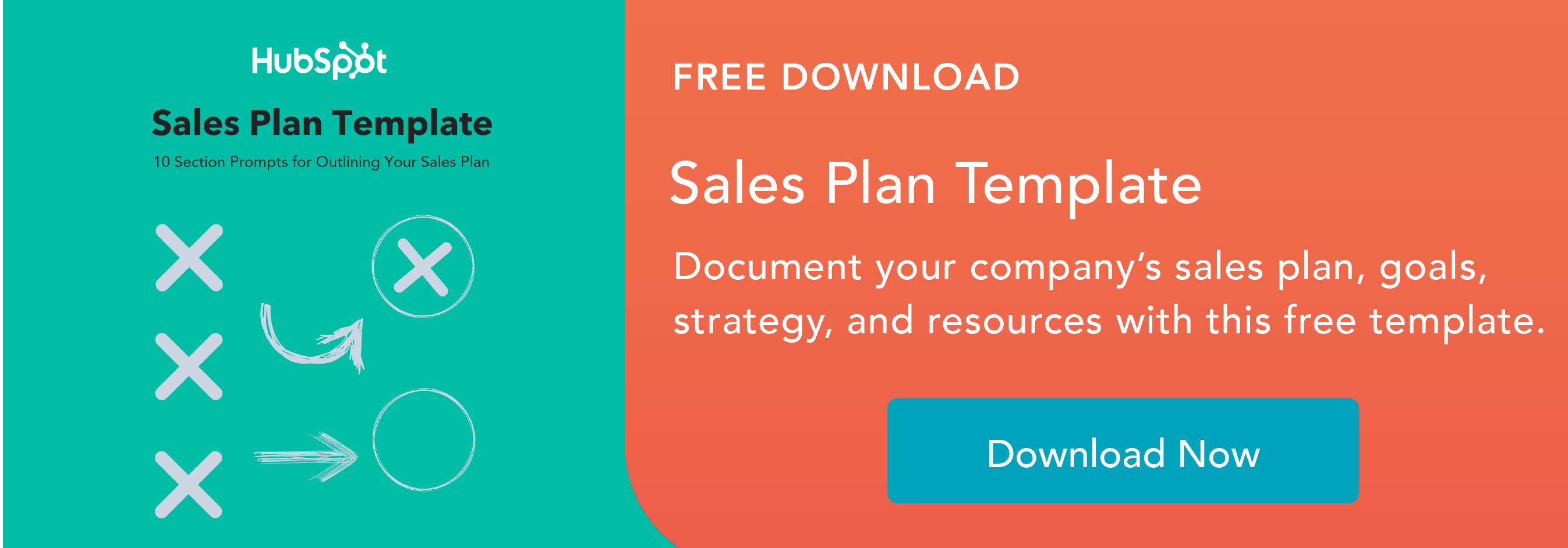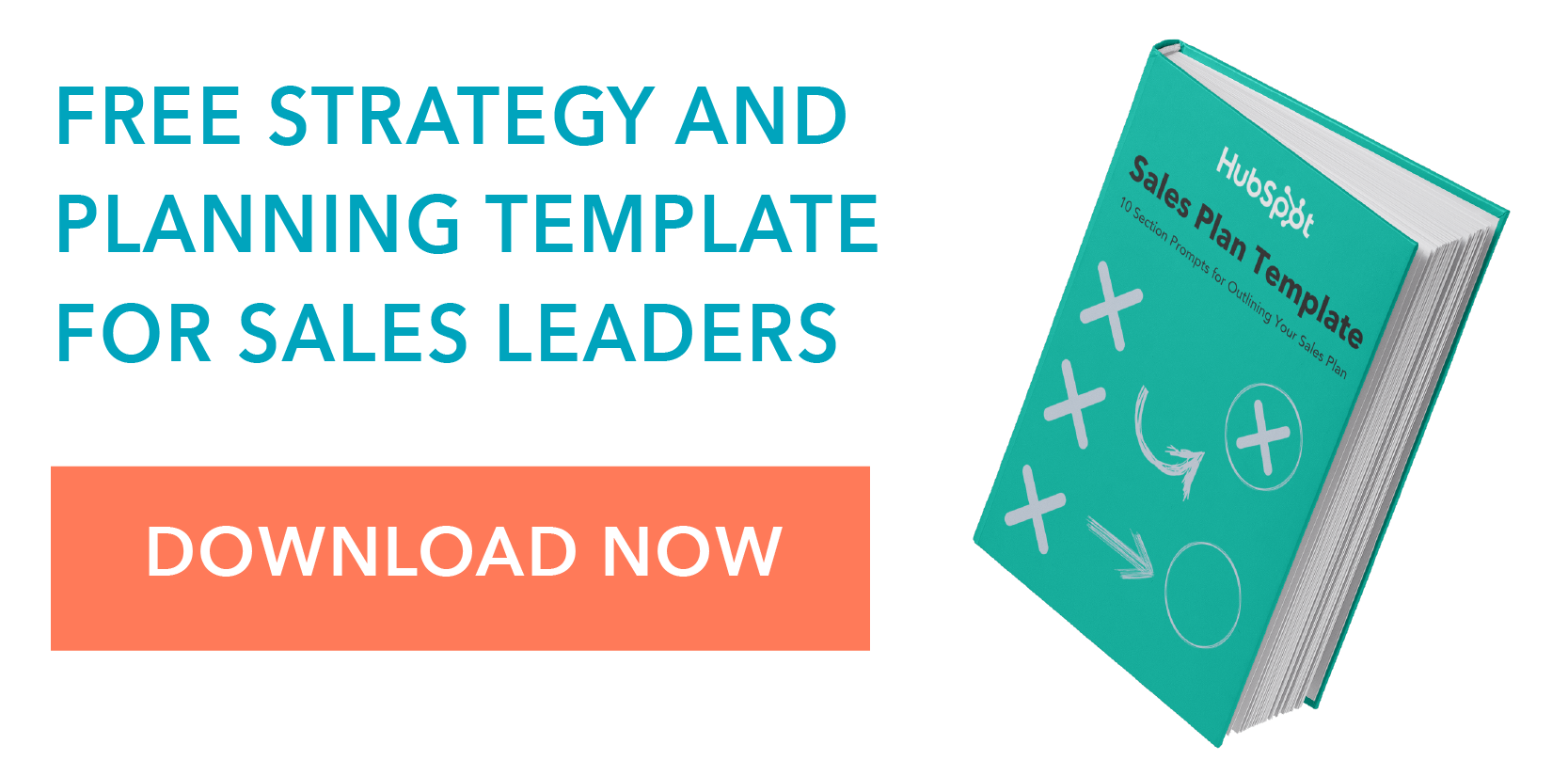The Ultimate Guide to Channel Sales
Document your channel sales strategy in this sales plan template.

One of the biggest challenges to scaling revenue? Your salespeople only have so much time. Even if you hire the most focused people, invest in tools that boost their efficiency, and remove all distractions, there’s a limited number of selling hours in the day.
Some companies choose to hire more reps.
Free Download: Sales Plan Template
That works – but it’s not the only solution. Plus, recruiting, hiring, and employing salespeople is expensive and cuts away at your margins.
Another potentially game-changing strategy: Using a channel sales model.
What is channel sales?
In a channel sales model, a company sells through third partners — affiliate partners (who get commission on each purchase), resellers, value-added providers (who typically bundle your product with their own), or another entity that doesn’t work for it directly.
With channel sales, you rely on third parties to sell your product or service. That can include resellers, affiliate partners, distributors, value-added providers, independent retailers – basically, anyone who doesn’t work directly for your organization.
Compare channel sales to the direct sales model, in which a company’s own reps sell to clients.
Here are the different topics related to channel sales we’re going to cover today:
The Benefits of a Channel Sales Model
The Drawbacks of a Channel Sales Model
Implementing a Channel Sales Model
How to Structure Your Channel Sales Partnership
How to Find Channel Sales Partners
How to Recruit Channel Sales Partners
How to Measure Your Channel Sales Program
Channel Sales Manager Job Description
How to Motivate Channel Sales Partners
So, which sales channels can you choose from? Here are some examples of sales channels through which you can sell your product or service.
Examples of Sales Channels
- Resellers
- Affiliate Partners
- Distributors
- Wholesalers
- Value Added Reseller (VAR)
- Independent Retailers
- Dealers
- Agents
- Consultants
1. Resellers
A reseller purchases a product from the company that produces it, and resells it to the intended end-user for profit. Essentially, a reseller serves as an intermediary between the company that makes or distributes a product, and the final customer.
In this scenario, the customer will typically go straight to the reseller to initiate the purchase and the reseller will work with their sourcing companies to fulfill the order.
2. Affiliate Partners
In an affiliate partnership, a retailer will pay commission to website owners, businesses, and individuals who promote their products. Affiliate partners are typically paid a percentage of each sale they are responsible for bringing in.
The Amazon affiliate program is a popular affiliate partnership platform.
3. Distributors
Distribution channels provide products directly to the consumer. Some distribution channels are agents, websites, or businesses that serve as intermediaries between the companies that produce the products and the final buyer.
4. Wholesalers
A wholesaler is a type of distributor who specializes in getting physical products on store shelves to be purchased by consumers. Wholesalers typically have sales reps who work to sell their products to retailers.
Common examples of wholesalers include suppliers who sell food and other goods to restaurants, and stores such as Costco who buy their goods directly from manufacturers and sell them to their customers.
5. Value Added Reseller (VAR)
Value added resellers are companies that specialize in purchasing and reselling technology products with additional software or features that are above and beyond the standalone features of the product.
For example, a computer company that sells hardware with software from another company pre-installed would be considered a value added reseller.
6. Independent Retailers
An independent retailer is a business owner who runs a retail company that is not tied to any major brand, franchise, or outside operational influences. For example, if an entrepreneur founded and operates a clothing boutique without the support of a parent company, they would be considered an independent retailer.
7. Dealers
Dealers sell products directly to end consumers, but operate differently than retailers who sell several variations of a wide variety of products. The most common type of dealer is an automobile dealer, that sells and leases cars directly to the end-user.
8. Agents
In this channel, agents serve as an intermediary who does not have any ownership over the products or services they are selling. Agents facilitate deals between buyers and sellers, assisting with the negotiation process.
A common example is real estate. A real estate agent or broker is not the owner selling the property to a buyer, however, they do oversee the process until an agreement is reached and the deal is closed.
9. Consultants
Channel consultants support the creation, and efficiency of sales channels. Individuals in this role often connect retailers, manufacturers, distributors, and vendors to ensure the smooth delivery of a product to its customer. Though channel consultants do not directly sell, they play an integral part in making sure sales channels are running smoothly.
The Benefits of a Channel Sales Model
Built-in trust: If your channel partner is already well-known within a market or vertical, you don’t have to do the work of establishing a brand presence. Your product will automatically seem more credible because of their endorsement.
Efficiency: One channel manager paired with several channel partners can bring in the same amount of revenue as five or six salespeople at a fraction of the cost. It’s also typically easier to bring on new partners than hire a new salesperson – especially once you’ve created the program and worked out the kinks.
Rapid testing: Channel partners let you experiment with new customer bases, products, packages, promotions, and/or marketing campaigns in a low-stakes environment.
Customer success: If your customers need training, onboarding, implementation support, and service, partnering with vendors who offer these services lets you focus on closing new business without sacrificing your existing users.
The Drawbacks of a Channel Sales Model
Less control: You’re not directly managing the sales process. Your reps might not be able to jump in and take control if a partner is mismanaging a deal. They also might have zero say over the timeline of the deal – which can be frustrating and lead to unpredictable revenue.
Brand risk: If you partner with someone who has a poor reputation or treats customers badly, you’ll look worse by association.
Reduced profits: In exchange for bringing in and/or closing deals, your partners will get a piece of the pie. You’ll make less on individual sales (but keep in mind, it’s probably cheaper to acquire each one).
Harder to manage: It can be difficult to update your sales strategy, change your messaging, add a new product, or make any kind of major shift. You’re not simply rolling out a change to one group – you’re asking multiple external groups to adapt.
Slower feedback cycle: Because your partners are talking to some or all of your customers, feedback will take longer to get to you. And that feedback might not be 100% accurate – even if your partners are trustworthy, they may ask bad questions, use unreliable methods of gathering and/or analyzing the results, or unintentionally give you a biased interpretation.
Potential conflict: Things can get very messy, very quickly when your direct salespeople compete with your partners for the same business. Suppose a rep decides to cut her partner out of the deal because she doesn’t want to give up the commission. If the partner finds out, he’s unlikely to ever pass her leads again.
Implementing a Channel Sales Model
Wondering if channel sales is right for your organization? Here are six things to consider.
Company size and maturity: Small companies can use partners to grow their business without needing to invest in hiring and training a sales team. Once they’re larger, they can bring their own reps on board (or if channel sales is working, continue with what they’re doing!).
Product maturity: If your product is still in the early stages, you might want to take advantage of a direct relationship with your customers so you can quickly and efficiently assess what’s working, what’s not, and what to build next.
Sales process maturity: Before you can teach other people how to sell your product, you need to understand how to sell it yourself. If you haven’t defined the various stages of your sales process, the most important buying triggers, which customer stakeholders are typically involved, how long the average deal takes to close, and so on, you may want to postpone a channel sales initiative.
In this case, consider taking the Inbound Sales Course to brush up on your skills, and build the confidence needed to refine your sales process.
Sales process complexity: Along similar lines, the lengthier and more complex your sales cycle, the harder it will be for your partners to resell. A simple, straightforward, relatively short process is ideal.
Location: If your offices are spread out, it might make sense to use a channel sales model. That makes creating multiple sales teams unnecessary. Of course, you can also use an inside sales model where appropriate.
Revenue needs: It takes a lot of time and energy to get a partner channel system up and running. If you need money sooner rather than later, focus on direct sales for now. Firas Raouf, an expert in early-stage B2B tech companies, recommends building at least $20 million in revenue before launching a partner sales program.
How to Structure Your Channel Sales Partnership
There are three main ways to structure channel sales.
First, you and your partner can sell together. Your products improve each other. For instance, if you offer catering services, you might partner with a company that provides event clean-up.
This type of partnership helps companies add more value to their customers.
Second, you can sell through your partner. Department stores are a classic example – they curate items from a range of third-party brands. Variety is typically the key. If you can find a partner who’s already selling several similar products to yours, they may be a good fit for this type of partnership.
Third, your partner can sell for you. These partners incorporate your product into theirs – in fact, the end user may never know about your company. When you go to the supermarket and buy the store brand, you’re actually buying an independent brand that’s been packaged with the grocery store’s label.
You don’t have to use one method exclusively. Many companies use two or even three of these simultaneously, along with a direct sales model. It all depends on your needs.
How to Find Channel Sales Partners
Just like trying to sell to everyone reduces your focus and actually harms your overall results, trying to partner with everyone is a bad idea.
The process of finding partners is almost identical to finding prospects: First, you need to define what an “ideal partner” looks like.
Components of an ideal channel sales partner:
Complementary solution: The partner’s product or service would fill a gap in your offering or help your customers use your offering more effectively.
For example, HubSpot’s marketing agency partners help small businesses take full advantage of HubSpot’s marketing software.
CeCe Bazar Aparo, vice president and general manager of corporate training at Hoffman, recommends interviewing your customer service and technical support teams.
“These people will be able to provide you with a real-world sense of exactly where customers need more help or are suggesting complementary products and services that might be best delivered by a partner channel,” she explains.
Market: You should also consider whether your partner’s customers would benefit from your product. Are they demanding additional support, features, or solutions that your partner can’t currently provide? Are their customers the right fit in terms of geography, use case, and size?
Marketing expertise: How sophisticated is the partner? You might have to do very little education and support – or you might have to do a great deal. Although training a partner requires more time and resources, it also gives them an additional incentive to work with you.
Technical expertise: Identify how much technical knowledge your partner would need to sell (and potentially service) your products. Do you need a partner with an outside sales team, an inside sales team, both, or neither?
Process: Your partner’s sales process should be compatible with yours. Ideally, there’s a natural point in their sales or services process for introducing or upselling your product.
Other partners: Can you work with a partner who’s already reselling another solution? Even if they’re not contractually forbidden from selling your product, will it be in their best interests?
Commitment level: Ask yourself how much commitment would be required for success. For example, maybe your partner would need to spend one full day per quarter at your office getting training. On the other end of the spectrum, perhaps all they need is a basic understanding of your product they can learn from one 30-minute video.
Your potential value: Even if a partner would be extremely valuable for your business, they won’t be interested in working with you unless they’re also benefitting. Figure out who you’d be able to help – by enabling them to sell additional services, reach new clients, or enhance the value of their product or service.
Once you’ve crafted your ideal partner persona, rank the characteristics by importance. This exercise will give you a framework for evaluating specific partners.
How to Recruit Channel Sales Partners
When HubSpot was building channel sales program, our team used inbound marketing principles to attract partners.
“From day one, we started hosting a lot of educational webinars that were directed specifically at marketing agencies and consultants. When they were over, I just sat back and watched the interest in our program fly in,” says Databox CEO and former HubSpot VP of Sales Pete Caputa.
Not only is this strategy easier to scale than an outbound one, but it also guarantees that your potential partners know about your company from the first conversation.
Use your ideal partner persona to craft relevant, useful content. For example, if you want to work with staffing firms, you might write an ebook on how to place consultants, or host a virtual networking event for staffing firms to meet job candidates.
Once you’ve started talking to a potential partner, Caputa advises making their needs the focus of the conversation.
“We found that the messages that resonated most with resellers revolved around how they could fix issues in their own business, as opposed to talking about our software and their client’s needs,” he says. “As it turned out (and this is still true today), most small and mid-sized marketing agencies and consultants need training on how to run their own business.”
Depending on the nature of the partnership, your partner might not be looking for (or you might not be able to afford) such a high-touch model.
If your average selling price (ASP) is low, and your partners resell your product relatively infrequently, investing so much into training them isn’t wise. Make sure you’re tracking how much revenue the average partner is bringing in compared to the average return. If this sounds familiar, it’s the CAC:LTV ratio applied to your partners.
How to Measure Your Channel Sales Program
Wondering what success looks like?
Here’s what to measure for every aspect of your channel sales program.
Channel sales recruitment metrics:
- Total number of partners
- Recruitment quota attainment
- Partner attrition rate
- Percentage of partners recruited by channel (for example, 50% from networking groups, 20% from proactive outreach, 10% from referrals, etc.)
- Average cost of recruiting and onboarding new partner
- Average length of time to recruit and onboard new partner
Channel sales success metrics:
- Total number of partner deals registered
- Average value of partner deal
- Percentage of accepted partner-submitted deals
- Percentage of closed partner-submitted deals
- Average sales cycle length
- Percentage of partners who registered lead in past month or quarter
- Channel sales training and support:
- Percentage of partners using provided sales and marketing collateral
- Percentage of partners who attend optional events and/or ongoing training
- Average partner satisfaction score
- Percentage of partners who attempted certification
- Percentage of partners who completed certification
Channel sales profitability metrics:
- CAC for partner sale versus direct
- Retention rates for partner sales versus direct
- Cross-sell and upsell rates for partner sales versus direct
Channel Sales Manager Job Description
Looking for someone to manage your channel partner relationships? Here’s a job description you can use.
Channel sales manager
A channel sales manager works with potential and existing channel partners to drive sales. They typically establish a strategy, help their partners implement it, and work toward a sales quota. The national average salary in the U.S. is$94,358.
[Company] is looking for a channel sales manager in [location]. This is an exciting opportunity to [grow a new channel, take a high-growth channel to the next stage]. As our channel sales manager, you’ll identify potential new partners, show them the value of working with [company], and enable existing customers to sell [product].
In this role, you will:
- Work with internal stakeholders (Support, Customer Service, Marketing, Legal, Direct Sales, etc.) to ensure partners have everything they need to successfully resell
- Ensure partner expectations are being met (or exceeded!)
- Ensure partners are following agreed-upon guidelines
- Proactively help partners hit their sales goals/milestones
- Give [demos, virtual presentations, in-person presentations] to potential partners
- Create demand using tools like marketing collateral, campaigns, webinars, events
- Communicate regularly with partners and company stakeholders
- Travel to customer and partner sites [on a weekly, monthly, quarterly basis/as needed]
We’re looking for someone who has:
- [X to Y] years of relevant experience in [consulting, channel sales].
- Experience working in [industry]. It’s a plus if you have established relationships with potential partners.
- Proven record of achieving in sales roles.
- Ability to work autonomously in a [fast-paced, technical, complex buying] environment.
- Excellent written and verbal communication skills.
- [BA/BS/MBA] [preferred, required].
- Ability to travel [X%] of the time.
What you’ll like about working for us:
- Aspect of your culture #1
- Aspect of your culture #2
- Work perk #1
- Work perk #2
Tailor this job description to your company’s employer branding. If you’re relatively formal, you may need to tweak the language so it’s less casual. If your messaging is typically relaxed and friendly, you might want to turn up the playfulness.
How to Motivate Channel Sales Partners
Channel sales is extremely challenging because you’re trying to motivate people you have no direct influence over. If a regular salesperson doesn’t meet quota, you can work with them and/or put them on a performance plan. If a partner isn’t selling – well, there’s not much you can do, apart from “fire” them from the program. That’s usually not the most desirable option.
To get partners to sell, try these strategies:
1. Develop excellent resources
You should invest twice as much in content for your channel partners as your direct reps. After all, your partners are much less familiar with the product, not to mention your direct competitors, existing customers, company history, and use cases. Make sure they’re armed with clear, comprehensive, prospect-ready product specs, testimonials, customer examples, competitive comparisons, email templates, call scripts, meeting agendas, and objection-handling cheat sheets.
Having this material will make partners feel more confident, which will boost their desire to sell.
2. Communicate often
If your partners rarely hear from you, they won’t be as invested in the program. They also won’t know the latest news, product updates, and strategic announcements. On your end, you might not discover issues until they’ve festered for a while.
The solution? Maintain regular contact with your partners. Send a periodic email, create a Slack room, make a Facebook group, hold partner “office hours,” run webinars, host meetings at your office – whatever you need to do to stay in touch.
3. Offer extra rewards
While earning commission on deals is a compelling incentive, some companies (like HubSpot) add additional reward systems to their partnership.
This lets you create “superpartners” and drive specific desired behaviors. For example, you might have a tiered system: One tier for basic partners, a higher tier for partners who sell over a specific amount per month or year, and a third tier for partners who sell over an even higher amount per month or year.
Depending on their tier, offer advanced marketing support, tickets to exclusive events, strategic consulting, meetings with your executives, access to beta features, premium listing in your directory, opportunities to interact directly with your audience, features in your email newsletter, and so forth.
Sales Channel Partnership Platforms
For scaling multi-channel businesses, keeping data related to your partnerships organized can be a challenge. Using a tool designed to keep your channel data streamlined can be a helpful option. Here are a few sales channel tools that can support your business as your channels and partnerships become more complex.
PartnerTap Channel Insights
- Price: Free, with paid plans available with additional features
PartnerTap’s Channel Insights tool empowers companies to automate channel mapping and scale their sales efforts. This platform provides in-depth analysis on your current accounts, showing where there is opportunity to grow current partnerships and helps users determine the viability and profitability of future partnerships.
PartnerTap is also part of the HubSpot Ecosystem, and their tools integrate flawlessly with your CRM.
Crossbeam
- Price: Free, with paid enterprise plans available
Crossbeam provides powerful software to manage channel partnerships. A major upgrade from spreadsheets, notable features of Crossbeam’s tool include real-time forecasting, instant account mapping, and cross-partner lead generation.
Crossbeam can also connect directly to HubSpot CRM, making co-selling and co-marketing even easier.
Channeltivity
- Price: Plans starting at $1,199 per month
Channeltivity’s partner relationship management software provides an all-in-one channel management solution. This cloud-based tool has an extensive set of features including a channel partner portal, partner training materials, distributor management, a commission management platform, and more.
Channeltivity also offers a HubSpot edition of their software which provides real-time pipeline visibility for businesses and partners.
While building a channel sales program is a major investment, it can make a huge difference to your company. Not only will you reach new customers, but you’ll develop mutually beneficial relationships throughout your space.
Originally published Nov 10, 2020 4:00:00 PM, updated November 10 2020
Topics:
Don’t forget to share this post!
Related Articles




